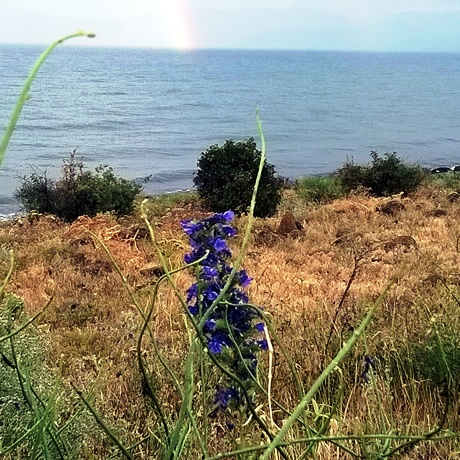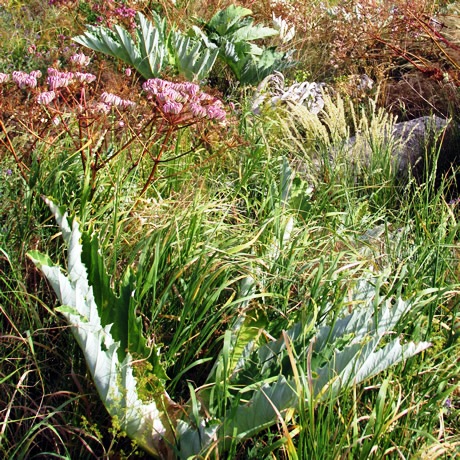Sevanavank
Sevanavank is a monastic complex sited on a peninsula on the north-western shore of Lake Sevan in the Gegharkunik Province of Armenia near the town of Sevan. The monastery started life off on a small island, although due to artificial drainage of the lake which began during the Stalin era, the water level fell and the island became the peninsula we see today.

Composite Image of Lake Sevan, near Sevanavank Monastery Complex
Due to the ease of access and the popularity of Lake Sevan as a tourist destination, Sevanavank is one of the most visited tourist sites in Armenia. In addition, historically it has been a place of pilgrimage. The peninsula sits between two contrasting climates with a steady supply of clouds from the mountains to the north drifting down onto the warm lake. This means it is possible to stand here and see fog on one side and sunshine the other.
The complex at Sevanavank consists of St. Arakelots (Holy Apostles) and Astvatsatsin (Holy Mother of God) churches, foundations for another church (St. Harutiun), a partially reconstructed site for monk cells and a ruined gavit (a common structure found on a church in a Medieval Armenian monastery which serves as an entrance to the church, mausoleum and assembly room). Both St. Arakelots and Astvatsatsin are cruciform plan structures with octagonal tambours, quite similar in appearance. Evidence shows the site to have been inhabited as far back at the Neolithic and Bronze Ages. The region was one of the first places that Christianity spread after becoming the state religion of Armenia in the year 301. Early on, two churches were established here (St. Harutiun and St. Karapet). According to an inscription on the south wall of St. Arakelots, the monastery of Sevanavank was founded in 874 by Princess Mariam, the daughter of Ashot I Bagratuni.

Composite Image of Sevanavank
The site has bore witness to many events in the history of Armenia, including the 10th century King, Ashot II, and his regiment camping here whilst defeating Arab rulers, pillaging during Mongol, Timurid and other invasions, recovery after the church's re-establishment in Armenia in 1441, and Soviet abandonment; St. Astvatsatsin was demolished in 1931. Further damage to the monastery occurred during the 1936 earthquake. Although, reconstruction and renovation took place in the 1950's, the monastery was not revived until the 1990's.
The photo gallery below shows the site at Sevanavank and Lake Sevan, as seen from the monastery complex. The two churches of St. Arakelots (Holy Apostles) and Astvatsatsin (Holy Mother of God) are shown (as an example) in Photo 5 on the left and right respectively. The partially reconstructed site for monk cells is shown in Photo 10. Walking uphill further along the peninsula takes you past the ruins of St. Harutiun church [Photo 15]. The lower left of Photo 46 shows the ruins of St. Astvatsatsin gavit. Also of note at the site are the khatchkars [Photo 39]. A khachkar in Armenia is a carved memorial stone bearing a cross, and often with additional motifs; they are characteristic of medieval Christian art in this part of the world. Some more information about Lake Sevan itself follows the photo gallery.
Lake Sevan
Lake Sevan is the largest lake in Armenia and in the Caucasus region. With an area of 940 km², it takes up 5% of Armenia's surface area. Lake Sevan is a freshwater mountain lake at a high altitude (approx. 1,900m) above sea level and on a sunny day it can have a distinctive deep turquoise colour. It is situated in the central part of the country 60km from the capital and largest city of Armenia, Yerevan, from which it has excellent transport links. With fresh water at about 18-22°C in the Summer and many uncrowded white sandy beaches, the lake offers a great escape for Yerevanians. Around the shores of the lake are various places to stay and as well as Sevanavank, there are several other monasteries and churches to visit (as well as plenty of beaches!).

Only 10% of the outgoing water from Lake Sevan is drained by the Hrazdan river; the other 90% evaporates. The level of the lake started to be artificially lowered from 1933 as the result of a project designed to maximise output from the lake's natural resources; over some years, the level of the lake dropped by 19 metres. However, an ecological disaster like the famous Aral Sea shrinking was avoided when the Stalinist era ended in 1956. After a committee was established to raise the lake's level again, stabilisation was reported in 1962. Work has continued ever since (with disruptions) as the ecological state of the lake and its surface level are still far from pre-1933 days.
In the Lake Sevan Basin, there are six species of fish (two endemic), four species of amphibians, 36 species of mammals, eighteen species of reptiles and over two hundred species of bird to be found; the lake is an important stop for migratory birds. In the basin of Lake Sevan, about 1,600 species of vascular plants, or half of Armenia's floral diversity, have been recorded. Returning to Sevanavank, above, although very small, the peninsula has two different climatic zones on the north and south sides and consequently quite different flora to be found.
 |
 |
|
 |
 |
Further Reading:
1. History of Sevanavank Here
2. Lake Sevan on WorldLakes.org Here
Back to Top